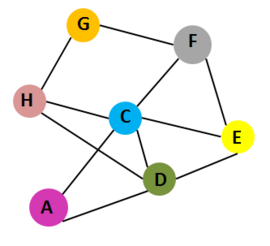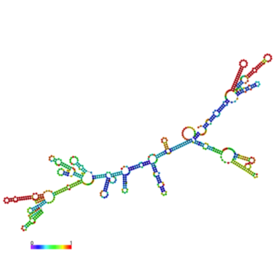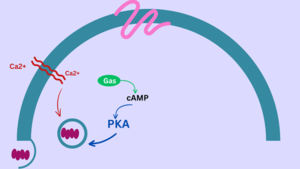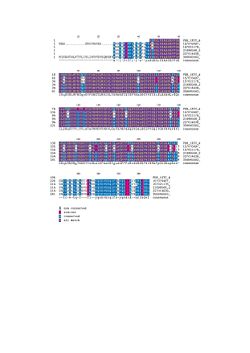Cholera toxin
From Proteopedia
(Difference between revisions)
| Line 2: | Line 2: | ||
[[Cholera toxin]] (CTX), secreted by bacterium [http://en.wikipedia.org/wiki/Vibrio_cholerae Vibrio Cholerae],is an oligomeric complex of enzymatic A and pentameric B subunits, which bind to the cell surface. CTX is the main cause of the diarrhea symptoms of cholera infection. | [[Cholera toxin]] (CTX), secreted by bacterium [http://en.wikipedia.org/wiki/Vibrio_cholerae Vibrio Cholerae],is an oligomeric complex of enzymatic A and pentameric B subunits, which bind to the cell surface. CTX is the main cause of the diarrhea symptoms of cholera infection. | ||
| - | |||
| - | '''PDB ID''': 1XTC | ||
| - | '''MMDB ID:''' 52036 | ||
== Structure == | == Structure == | ||
| - | [[Image:CTX interaction.PNG|left|270px|thumb| Interaction of 7 chains of Cholera toxin[[1xtc]]. Cholera toxin contains 7 chains: A,C,D,E,F,G and H.Chains A and C belong to subunit A. Chains C,D,E,F,G and H belong to subunit B]] | + | [[Image:CTX interaction.PNG|left|270px|thumb| Interaction of 7 chains of Cholera toxin [[1xtc]]. Cholera toxin contains 7 chains: A,C,D,E,F,G and H.Chains A and C belong to subunit A. Chains C,D,E,F,G and H belong to subunit B]] |
| + | {{Clear}} | ||
Cholera toxin(CTX) has two types of subunits: subunit A and subunit B. A subunit contains A1 domain, which includes the enzymatic active site, and A2 domain, which has a α–helix tail. The B subunit contains five chains that form a pentameric ring around the central pore in structure; Subunit A and subunit B are assembled by the α–helix tail of A2 domain, which inserts into the central pore. CTX is the main virulence factor of the pathogen ''Vibrio cholerae'' and cause the major symptom of infection: extreme diarrhea, vomiting, cramps and even death <ref>Ryan KJ; Ray CG (editors) (2004). Sherris Medical Microbiology (4th ed.). McGraw Hill. p. 375. ISBN 0838585299.</ref>,<ref>Faruque SM; Nair GB (editors). (2008). Vibrio cholerae: Genomics and Molecular Biology. Caister Academic Press. ISBN 978-1-904455-33-2.</ref>,<ref>Jennifer McDowall, Cholera Toxin, EMBL-EMI, Interpro</ref>. | Cholera toxin(CTX) has two types of subunits: subunit A and subunit B. A subunit contains A1 domain, which includes the enzymatic active site, and A2 domain, which has a α–helix tail. The B subunit contains five chains that form a pentameric ring around the central pore in structure; Subunit A and subunit B are assembled by the α–helix tail of A2 domain, which inserts into the central pore. CTX is the main virulence factor of the pathogen ''Vibrio cholerae'' and cause the major symptom of infection: extreme diarrhea, vomiting, cramps and even death <ref>Ryan KJ; Ray CG (editors) (2004). Sherris Medical Microbiology (4th ed.). McGraw Hill. p. 375. ISBN 0838585299.</ref>,<ref>Faruque SM; Nair GB (editors). (2008). Vibrio cholerae: Genomics and Molecular Biology. Caister Academic Press. ISBN 978-1-904455-33-2.</ref>,<ref>Jennifer McDowall, Cholera Toxin, EMBL-EMI, Interpro</ref>. | ||
The enzymatic subunit has a globular domain (CTA1) and a long helical domain (CTA2). Once the CTX binds to the cell surface, it is internalized, and its CTA1 domain binds to ADP-ribosylation factor 6(Arf6)[http://en.wikipedia.org/wiki/ADP_ribosylation_factor], enabling its catalytic activity. | The enzymatic subunit has a globular domain (CTA1) and a long helical domain (CTA2). Once the CTX binds to the cell surface, it is internalized, and its CTA1 domain binds to ADP-ribosylation factor 6(Arf6)[http://en.wikipedia.org/wiki/ADP_ribosylation_factor], enabling its catalytic activity. | ||
| - | + | ||
[[Image:1xtc.png|right|280px|thumb|Crystal Structure of Cholera toxin [[1xtc]]]] | [[Image:1xtc.png|right|280px|thumb|Crystal Structure of Cholera toxin [[1xtc]]]] | ||
| Line 58: | Line 56: | ||
**[[1tet]] – CTX peptide 3+FAB light and heavy chains - mouse | **[[1tet]] – CTX peptide 3+FAB light and heavy chains - mouse | ||
}} | }} | ||
| + | == See also [[Toxins]] == | ||
== Multiple Sequence Alignment == | == Multiple Sequence Alignment == | ||
[[Image:MSA1.jpg|left|250px|thumb|Multiple Sequence Alignment-TEXSHADE result.BlastP of CTX A subunit that contains six different species. This is made by Biology Workbench]] | [[Image:MSA1.jpg|left|250px|thumb|Multiple Sequence Alignment-TEXSHADE result.BlastP of CTX A subunit that contains six different species. This is made by Biology Workbench]] | ||
Revision as of 12:57, 18 January 2016
| |||||||||||
Contents |
3D Structures of Cholera toxin
Updated on 18-January-2016
See also Toxins
Multiple Sequence Alignment
Selected Sequences:
1. Cholera toxin Subunit A
2. Escherichia coli E24377A plasmid pETEC_80, complete sequence
3. Escherichia coli strain 214-III elt operon, complete sequence
4. Vibrio cholerae strain JS9803 prophage Vibrio phage CTX Zot (zot)
5. Vibrio cholera O395 chromosome II, complete sequence
6. Vibrio cholera O1 str. 2010EL-1786 chromosome 1, complete
Reference
- ↑ Ryan KJ; Ray CG (editors) (2004). Sherris Medical Microbiology (4th ed.). McGraw Hill. p. 375. ISBN 0838585299.
- ↑ Faruque SM; Nair GB (editors). (2008). Vibrio cholerae: Genomics and Molecular Biology. Caister Academic Press. ISBN 978-1-904455-33-2.
- ↑ Jennifer McDowall, Cholera Toxin, EMBL-EMI, Interpro
- ↑ Jennifer McDowall, Cholera Toxin, EMBL-EMI, Interpro
- ↑ Davis B, Waldor M (2003). "Filamentous phages linked to virulence of Vibrio cholerae". Curr Opin Microbiol 6 (1): 35–42. doi:10.1016/S1369-5274(02)00005-X. PMID 12615217.
- ↑ Luppi P.H.. "The Discovery of Cholera-Toxin as a Powerful Neuroanatomical Tool". Retrieved 2011-03-23.
- ↑ Luppi P.H., Fort P., Jouvet M. Iontophoretic application of unconjugated cholera toxin B subunit (CTb) combined with immunohistochemistry of neurochemical substances: a method for transmitter identification of retrogradely labeled neurons. Brain Res. 534 (1-2) pages : 209-224 (1990)
External Links
PDB ID: 1XTC [1]
MMDB ID: 52036 [2]
PubMed[3]





